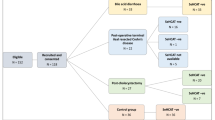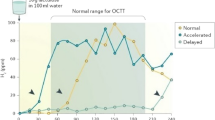Abstract
The synthetic substrate cholyl-PABA, developed by conjugating cholic acid with paraaminobenzoic acid, is hydrolyzed by the bacterial enzyme cholyl hydrolase to release free PABA. This study aimed to evaluate whether quantitating urinary excretion of PABA after oral administration of cholyl-PABA can detect small intestinal bacterial overgrowth. In the first phase, investigations were performed on 10 healthy volunteers to study the dynamics of urinary excretion of PABA and any adverse reactions after oral administration of 1.2 g of cholyl-PABA. Another 10 healthy volunteers and 25 adult patients with various gastrointestinal disorders participated in the second phase, where the urinary cholyl-PABA test was compared to the [14C]xylose breath test (XBT). The upper limit of normal levels of urinary PABA excretion at the end of 4 h was 1.1% of the administered dose of cholyl-PABA. The urinary PABA excretion after 4 hr [median (range), in percentage] in the XBT-positive group was 1.6 (0.6–35.0), which was significantly higher than those in the XBT-negative group [0.7 (0.4–1.8)] and the healthy controls [0.7 (0.2–1.1)]. The agreement between the XBT and the urinary cholyl-PABA test was 85.7% (P < 0.01). No adverse effect was noted. In conclusion, the urinary cholyl-PABA test offers a simple, safe, noninvasive, and rapid method for diagnosing small intestinal bacterial overgrowth and warrants further clinical evaluation.
Similar content being viewed by others
REFERENCES
Banwell JG, Kister LA, Gianella RA, Weber FL, Lieber A, Powell DE: Small intestinal bacterial overgrowth syndrome. Gastroenterology 80:834-845, 1981
Toskes PP, Kumar A: Enteric bacterial flora and bacterial overgrowth syndrome. In Sleisinger and Fordtran's Gastrointestinal Disease Pathophysiology, Diagnosis, Management, 6th ed. M. Feldman, BF Scharschmidt, MH Sleisenger (eds). Philadelphia, WB Saunders, 1998, pp 1523-1535
Bardhan PK, Albert MJ, Alam NH, Faruque SM, Neogi PKB, Mahalanabis D: Small bowel and fecal microbiology in children suffering from persistent diarrhea in Bangladesh. J Pediatr Gastroenterol Nutr 26:9-15, 1998
Kirsch M: Bacterial overgrowth. Am J Gastroenterol 85:231-237, 1990
Bardhan PK, Gyr K, Beglinger C, Vogtlin K, Frey R, Vischer W: Diagnosis of bacterial overgrowth after culturing proximal small bowel aspirate obtained during routine upper gastrointestinal endoscopy. Scand J Gastroenterol 27:253-256, 1992
King CE, Toskes PP: The use of breath tests in the study of malabsorption. Clin Gastroenterol 12:591-610, 1983
King CE, Toskes PP: Comparison of the 1-gram 14C-xylose, 10-gram lactulose-H2, and 80-gram glucose-H2 breath tests in patients with small intestinal bacterial overgrowth. Gastroenterology 91:1447-1451, 1986
Imondi AR, Stradley RP, Wolgemuth RL: Synthetic peptides in the diagnosis of exocrine pancreatic insufficiency in animals. Gut 13:726-731, 1972
Gyr K: Tests of Exocrine Pancreatic Function. Switzerland, Hans Huber 1975, pp 92-112
Wohlgemuth RL, Hanson KM, Zassenhaus PH: A new substrate for the rapid evaluation of enteric microbial overgrowth. Dig Dis 21(9):821-826, 1976
Lack L, Dorrity FO Jr, Walker T, Singletary GD: Synthesis of conjugated bile acids by means of a peptide-coupling reagent. J Lipid Res 14:367-370, 1973
Smith HW, Finkelstein N, Aliminosa L, Crawford B, Graber M: The renal clearance of substituted hippuric acid derivatives and other aromatic amines in dog and man. J Clin Invest 24:388-404, 1945
Dellert SF, Nowicki MJ, Farrell MK, Delente J, Heubi JE: The 13C-xylose breath test for the diagnosis of small bowel bacterial overgrowth in children. J Pediatr Gastroenterol Nutr 25:153-158, 1997
Lewis R, Gorbach S: Modification of bile acids by intestinal bacteria. Arch Intern Med 130:545-549, 1972
Shindo K, Yamazaki R, Mizuno T, Shionoiri H, Sugiyama M: Deconjugation ability of bacteria isolated from the jejunal fluids in the blind-loop syndrome with 14CO2 excretion-using the breath analysis technique and thin layer chromatography. Life Sci 45:2275-2283, 1989
Hepner GW, Hofmann AF, Malagelada JP, Szczepanik PA, Klein PD: Increased bacterial degradation of bile acids in cholecystectomised patients. Gastroenterology 66:556-564, 1974
Hepner GW: Increased sensitivity of the cholyglycine breath test for detecting ileal dysfunction. Gastroenterology 68:8-16, 1975
Fromm H, Thomas PJ, Hofmann AF: Sensitivity and specificity in tests of distal ileal function: Prospective comparison of bile acid and vitamin B12 absorption in ileal resection patients. Gastroenterology 64:1077-1090, 1973
Maeda Y, Takahashi M, Tashiro H, Akazawa F: The rapid evaluation of intestinal bacterial growth using a conjugate of ursodeoxycholic acid with paraaminobenzoic acid. J Pharmacobio-Dyn 12:272-280, 1989
Takahashi M, Maeda Y, Tashiro H, Eto T, Goto T, Sanada O: A new simple test for evaluation of intestinal bacteria. World J Surg 14:628-634, 1990
Konishi T, Takashi M, Ohta S: Basic studies on 5-(7-hydroxy-3-O-phosphonocholyl) aminosalicylic acid for the evaluation of microbial overgrowth. Biol Pharm Bull 20:370-375, 1997
Kiss ZF, Wolfling J, Csati S, Nagy F, Wittmann T, Schneider G, Lonovics J: The ursodeoxycholic acid-p-aminobenzoic acid deconjugation test, a new tool for the diagnosis of bacterial overgrowth syndrome. Eur J Gastroenterol Hepatol 9:679-682, 1997
Weizman Z, Forster GG, Gaskin KJ, Kopelman H, Wong S, Durie PP: Bentiromide test for assessing pancreatic dysfunction using analysis of paraaminobenzoic acid in plasma and urine. Gastroenterology 89:596-604, 1985
Mitchell CJ, Humphrey CS, Bullen AW, Kelleher J, Losowsky MS. Improved diagnostic accuracy of a modified oral pancreatic function test. Scand J Gastroenterol 14:737-741, 1979
Puntis JW, Berg JD, Buckley BM, Booth IW, McNeish AS: Simplified oral pancreatic function test. Arch Dis Child 63:780-784, 1988
Suhr O, Danielsson A, Horstedt P, Stenling R: Bacterial contamination of the small bowel evaluated by breath tests, 75Selabeled homocholic-tauro acid, and scanning electron microscopy. Scand J Gastroenterol 25:841-852, 1990
Author information
Authors and Affiliations
Rights and permissions
About this article
Cite this article
Bardhan, P.K., Feger, A., Kogon, M. et al. Urinary Choloyl-PABA Excretion in Diagnosing Small Intestinal Bacterial Overgrowth. Dig Dis Sci 45, 474–479 (2000). https://doi.org/10.1023/A:1005428703993
Issue Date:
DOI: https://doi.org/10.1023/A:1005428703993




